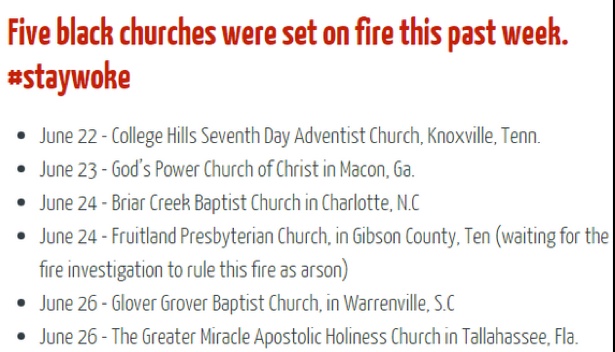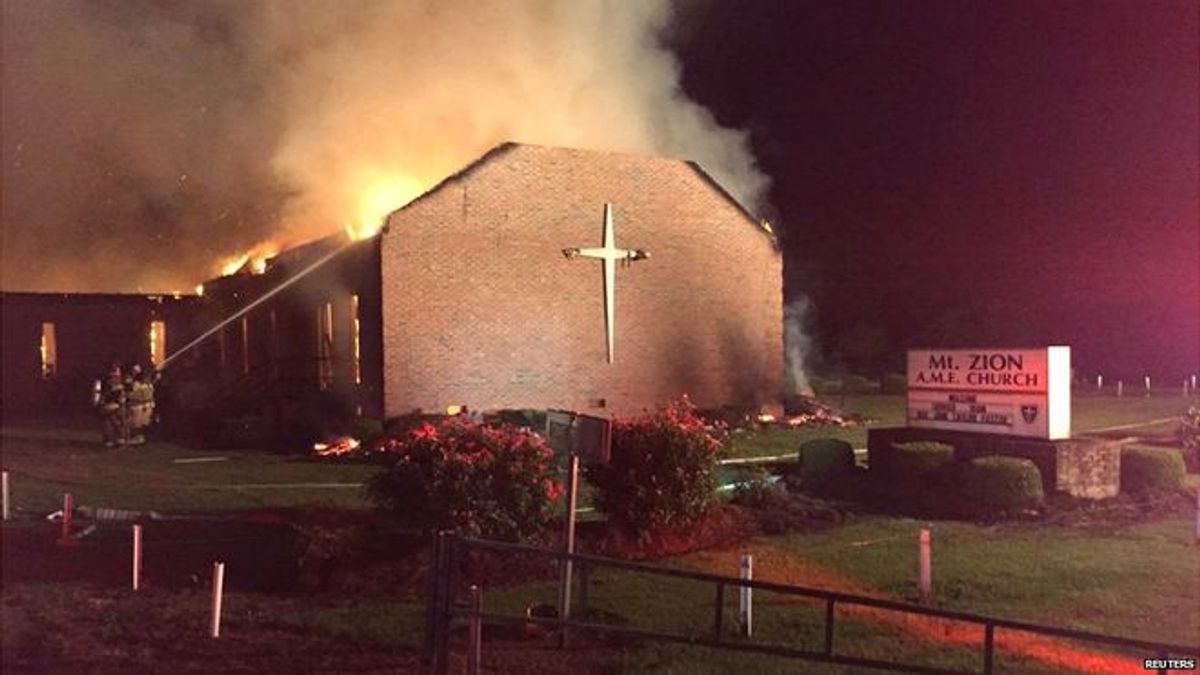NEWS: What appeared to be a spate of arsons at Southern black churches following the Charleston massacre was likely a function of confirmation bias.
On 17 June 2015, nine people were killed in a racially motivated shooting at the Emanuel African Methodist Episcopal Church in downtown Charleston, South Carolina. In the days and weeks that followed that tragedy, widespread reports of arson involving black churches in the South began circulating in news and social media:

The issue came to widespread attention after the Alabama-based civil rights group Southern Poverty Law Center's (SPLC) HateWatch blog published an article on
In what may not be a coincidence, a string of nighttime fires have damaged or destroyed at least six predominately black churches in four southern states in the past week.
Arsonists started at least three of the fires, while other causes are being examined in the other fires, investigators say..
Federal agents have been brought in to assist local officials in determining the unknown cause of the fire at the Glover Grove Baptist church. In Tallahassee, fire officials say the fire that totally destroyed the Apostolic Holiness Church may have been caused by a tree limb falling on overhead electrical lines.
On 1 July 2015, the Atlantic published an article titled "Black Churches Are Burning Again in America," with a tagline stating that "[a]rson at religious institutions has decreased significantly over the past two decades, but the symbolism remains haunting." Adopting a more editorial and historical approach to church fires in general, the article addressed both the context in which black church arson events occurred during various points in American history and the circumstances under which a church fire definitively constitutes a hate crime.
The latter point appeared in one portion of the piece, particularly with respect to the meaningful differences between fires that are "suspicious," "intentional," or intentionally motivated as hate crimes against black congregations:
The National Fire Protection Association reports that between 2007 and 2011, there were an average of 280 intentionally set fires at houses of worship in America each year, although a small percentage of those took place at other religious organizations, like funeral homes. One of the organization’s staffers, Marty Ahrens, said that tracking church arson has become much more complicated since reporting standards changed in the late ‘90s. Sometimes, fires that are reported to the National Fire Incident Reporting System are considered “suspicious,” but they can’t be reported as arson until they’re definitively ruled “intentional.” Even then, it’s difficult to determine what motivated an act of arson. “To know that something is motivated by hate, you either have to know who did it or they have to leave you a message in some way that makes it very obvious,” she said. “There are an awful lot of [intentionally set fires] that are not hate crimes — they’re run-of-the-mill kids doing stupid things.”
The article asserted that "no matter why they happened, these fires are a troubling reminder of the vulnerability of our sacred institutions (after the [Charleston] massacre)," noting that it was "true that a stupid kid might stumble backward into one of the most symbolically terrifying crimes possible in the United States, but that doesn’t make the terror of churches burning any less powerful."
As was commonplace after the publication of the SPLC article, news outlets (and the image meme seen above) charted all fires in black churches that occurred during the period of increased interest around the Charleston shooting, some of which were later deemed not to be suspicious or intentionally set. According to a
The fire in [Greeleyville, South Carolina] brings to seven the number of churches, six of them with predominantly African-American congregations, that have burned in the last 10 days in South and North Carolina, Tennessee, Georgia and Florida. Two of those appear to have been caused by lightning, and another was electrical.
Investigators have found no evidence that any of the fires are connected and no indications of hate crimes. At least two were deliberately set, investigators said, with two still of unclear origins.
Predictably, the passage of time between what appeared to be an uptick of fires at black churches (late June 2015) and updates about the investigations (early July 2015) resulted in a lingering belief that seven black churches were deliberately set ablaze in the week after the Charleston church shooting. Social media users continued to repeat the claim that seven black churches had been victims of arson despite the later findings:
Reality: 7 black churches attacked by white people in the past week
CNN: ISIS and Muslims
Fox News: ISIS and Muslims
— ️Austin (@kvxll) July 6, 2015
We are still asking: Who is burning Black churches? https://t.co/GLPemUstMs pic.twitter.com/SqoNAQanNQ
— Black Youth Project (@BlackYouthProj) July 6, 2015
Why is there not more outrage over burned black churches? https://t.co/mvlPrO5g9H pic.twitter.com/ne34t7etV9
— The Root (@TheRoot) July 6, 2015
#YouMightBeARacist if you were upset about CVS being burned down but not black churches. #justsaying pic.twitter.com/8xRSpAEITM
— Coco Hilliard (@CocoHilliard) July 5, 2015
Twitter and Facebook were not solely responsible for the rumor's advancement. On
While Twitter has been trending the #whoisburningblackchurches hashtag, the mainstream corporate news media has been relatively silent: There is no mass panic about what seems to be a highly unusual series of events in the aftermath of the Charleston massacre, the F.B.I.’s report on the extreme threat posed by Right-wing domestic terrorists, and the increase in white hate group activities in the Age of Obama.
However, a 1 July 2015 article in the Washington Post titled "The good news: There probably isn’t an unusual rash of arsons at black churches" looked not only at the cause of the fire in Greeleyville (not arson), but the statistical likelihood of church fires at any given time (and whether the ostensible increase in incidents was in fact an uptick in the fire rate at all):
But that fire [in Greeleyville] wasn't arson, and there have been a number of fires at non-black churches since June 20, too — including arsons. It seems that the reported trend is more a function of our habit of seeking out patterns than any abnormal targeting of black churches.
"Abnormal" is an important word there. A 2000 investigation into church arsons found 945 examples between January 1995 and that August — an average of 14 a month. In the South, those fires were disproportionately at churches with black congregations. Other data suggests that arsons at churches could occur as often as five times a week.
Ultimately, what appeared (during a period of heightened awareness and sensitivity) to be a rash of attacks on black churches after the Charleston massacre was not likely evidence of an actual increase in attacks on the affected houses of worship. Several of the fires were found to be accidental; and in the cases of the two ruled to be arson, the intent of their perpetrators was not clear.
